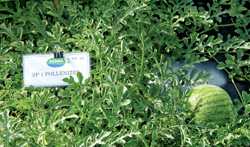Planting Pollenizers Strategy For Watermelon Production

In 2005, about three-fourths of the U.S. watermelon production was devoted to seedless watermelon. To produce seedless melons, a portion of the plants in the field must be seeded watermelon plants and they must be placed about 15 feet from the seedless watermelon plants.
Seeded plants that produce seeded fruit provide viable pollen (pollenizer plants) for fruit set because seedless watermelon plants do not produce viable pollen. These pollenizer plants can be planted in separate rows or placed in between (interplanted) in the same row as the seedless plants.
When planting only a pollenizer plant in a separate row, the next two to four rows should be exclusively planted with seedless watermelon. Planting an entire row with only pollenizer or seedless plants simplifies planting and avoids the possibility of confusing the two plant types. Pollenizer plants can also be planted in the same row with seedless plants using two strategies.
Pollenizer Planting Strategies
One strategy is to plant a pollenizer in every third or fourth hill that would normally be occupied by a triploid plant. Another is to place the pollenizer plant in between every two to three seedless plants rather than occupying a hill for a seedless plant.
Placing the pollenizer in the row with triploid plants rather than in separate rows can be a plus because honeybees often work down a row rather than across rows. Another advantage to interplanting the pollenizer with the seedless plants is the viable pollen is often closer to the fruit-bearing flowers.
Bees are required to move the viable pollen from the male flowers to the female (fruit bearing) flowers of watermelon. While seeded watermelon only require six to eight bee visits for fruit set, seedless watermelon female flowers need at least 16 bee visits when one pollenizer plant is planted for every three seedless watermelon plants.
Selecting a cultivar that produces high amounts of pollen is another consideration when choosing a pollenizer. Seed companies have developed special pollenizers that are seeded cultivars developed exclusively for use as pollen donors to produce seedless watermelons. In other words, the fruit produced from the special pollenizer cultivars are not grown for sale.
The first special pollenizers released about five years ago were Companion from Seminis Inc. and SP-1 from Syngenta Seeds Inc./ROGERS Brand. Since then, other companies have introduced their version of the special pollenizer, and now there are about 10 sold commercially.
We have evaluated many with respect to plant growth habit and the production of male flowers over time. Male flower production is an important measure because it is indicative of the potential source of pollen that is available for seedless fruit production. Several of these special pollenizers can be used to optimize the yields of seedless watermelons since they are less competitive with seedless watermelon plants and are inter-planted rather than hill planted.









